Scythe Grand Kama Cross Rev. B Processor Cooler Review

The second revision of the Japanese Scythe Grand Kama Cross top-cooler had a very pleasant surprise hidden up its sleeve. Today we are going to unveil what it is.
This isn’t a secret that things have been kind of slow in the CPU air-cooling segment for quite some time. There is nothing principally new and particularly exciting in terms of increased cooling efficiency or lower noise, and most manufacturers merely add some cosmetic tune-ups to the existing products and implement new platforms support. The best example here will be the “new” Scythe Grand Kama Cross Rev. B released in mid-2012.
Over three years ago the Japanese Scythe Company, Ltd. launched the first revision of this cooler. And do you know what they have modified in the cooler design since then? Nothing! In fact, there are absolutely no constructive changes in Rev. B compared with the very first Grand Kama Cross. The only thing that let Scythe claim it was in fact a new revision is the LGA 2011 support and formal support of AMD Socket FM1 and FM2, which simply didn’t exist back in 2009-2010. Nevertheless, we decided to check the cooling efficiency of this product once again, especially since our today’s testbed is based on an LGA 2011 processor. Let’s see what the unique top-cooler from Scythe is capable of on a six-core CPU.
Technical Specifications and Recommended Pricing
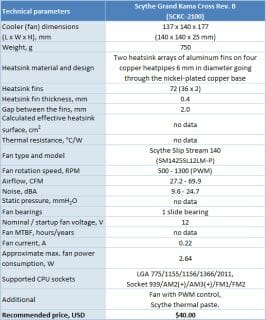
Packaging and Accessories
The box with Scythe Grand Kama Cross Rev. B cooler is a cardboard cube with a tab at the top:
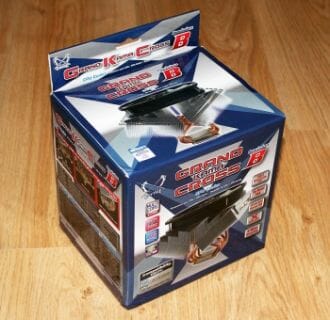
The front of the box has an image of the cooler and a list of all supported processor sockets. The sides have technical specifications, photographs of the retention kits, warranty terms and conditions and key peculiarities:
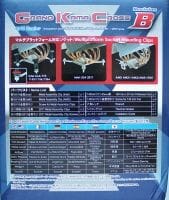
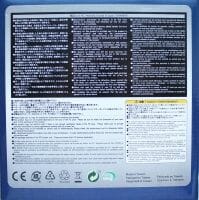
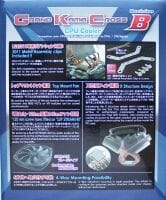
The cooler is accompanied with LGA 775/1155(6)/1366 retentions kits with plastic push-pins, universal AMD kit, an LGA 2011 kit with a wrench and screws, Scythe thermal paste and assembly and installation instructions guide:
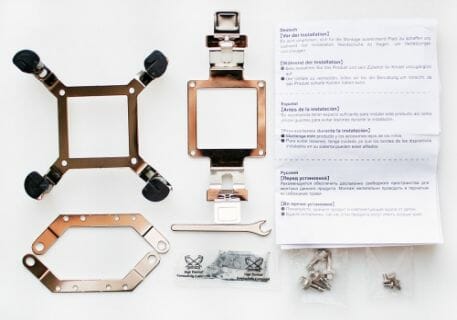
The cooler is made in Taiwan. Its current retail price is around $40. Scythe Grand Kama Cross Rev. B comes with 2-year warranty like all other coolers from Scythe.
Design and Functionality
Scythe Grand Kama Cross doesn’t look ordinary at all. While it is a top-cooler (with the airflow directed towards the mainboard PCB), it consists of two aluminum heatsink arrays installed at a 40-degree angle to the mainboard surface (the so-called X-structure). There is a 140 mm fan attached at the top:
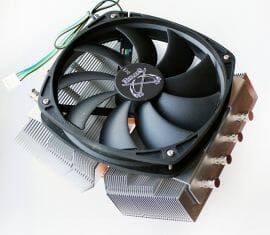
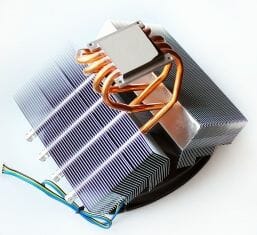
It weighs 750 grams, which isn’t much, according to today’s standards in CPU cooling field. It measures 177x140x137 mm and the details dimensions are provided on the following pictures:
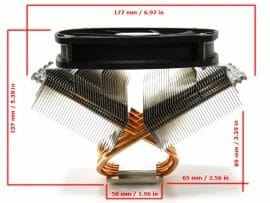
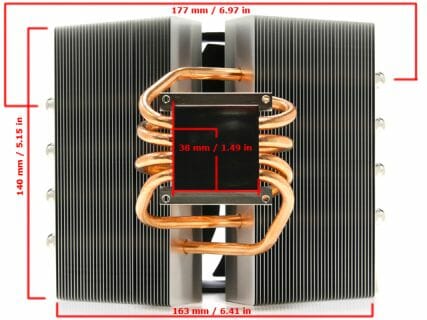
There is a total of 72 heatsink fins, 36 per array. The fins in each array are arranged in three groups, 12 per group, and the lower they sit on the heatpipes, the longer they are:
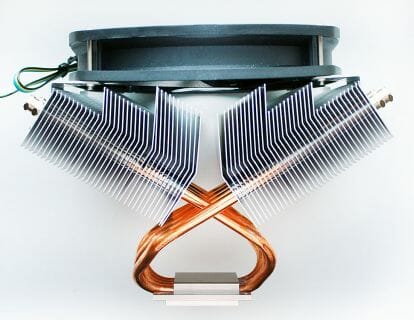
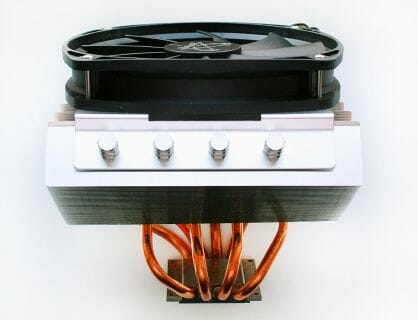
This design approach allowed Scythe to use the heatsink surface beneath the fan in the most efficient manner, while directing the airflow right to the heated components in the area around the processor socket. The fins pressed firmly against the heatpipes are 0.4 mm thick, and the gaps between them are about 2.0 mm.
This sectional design of the heatsink resulting into variable length of the heatsink fins produced another tangible advantage: lower airflow resistance:
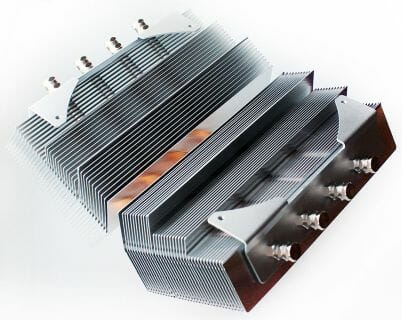
So, we may assume that Scythe Grand Kama Cross should also be quite efficient even at lower fan rotation speeds.
The fan is 140 mm in diameter and covers the entire heatsink:
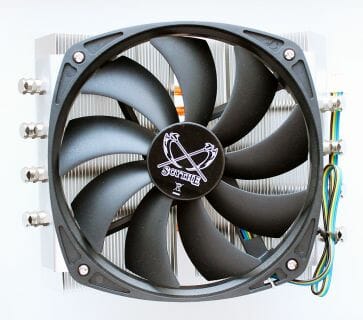
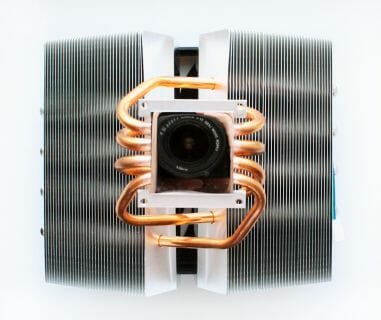
Grand Kama Cross has four heatpipes 6 mm in diameter. They are soldered to the base, but we have to point out that there are no grooves in the base plate, which is 4 mm thick:
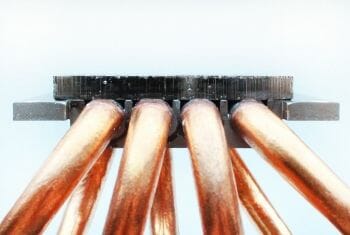
The heats-spreader base plate is 38×38 mm big, has exceptionally even surface polished to mirror-shine:
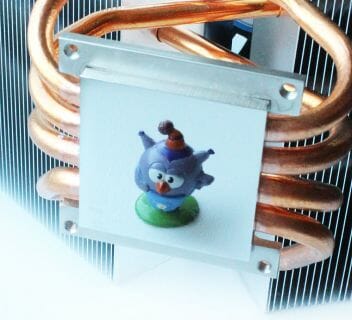
The thermal paste imprint on the LGA 2011 processor heat-spreader was very uniform and practically perfect in all respects:
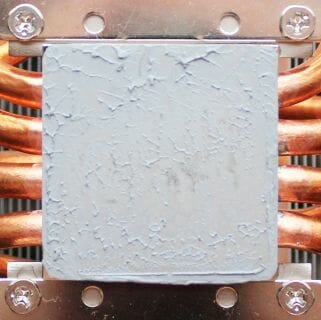
The second revision of Scythe Grand Kama Cross comes with the same exact nine-blade fan, as the very first one. It is Scythe Slip Stream 140 PWM with retention holes to match the 120 mm fan landing spots:
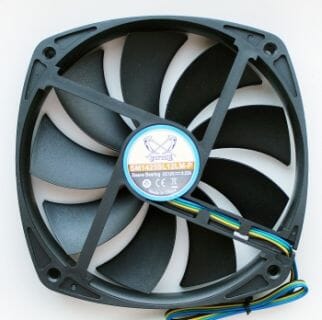
This model is marked as SM1425SL12ML-P. Its rotation speed may be adjusted using pulse-width modulation method (PWM) in the interval from 500 to 1300 RPM (±10%). The declared noise level is 9.6-24.7 dBA, while the airflow should be within 27.2-69.9 CFM range. The slide bearing in the fan motor should last at least 30,000 hours.
Maximum fan power consumption should reach 2.64 W at 0.22 A current. Everything is pretty modest, so to speak. The rotor diameter is 39 mm, and the non-sleeved four-wire cable is 300 mm long.
Compatibility and Installation
As we have already mentioned above, Scythe Grand Kama Cross Rev. B can be installed onto any contemporary platform, including LGA 2011. The installation procedure is fairly simple and doesn’t require removing the mainboard from the system case. First, you attach the appropriate retention brackets to the base of the cooler with enclosed screws:
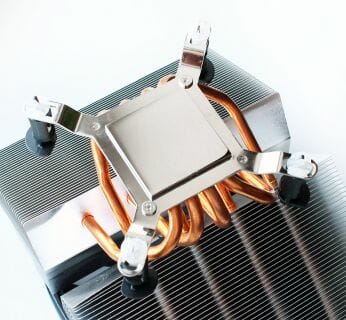
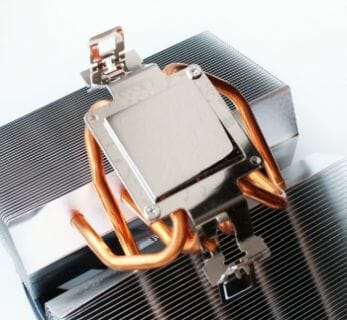
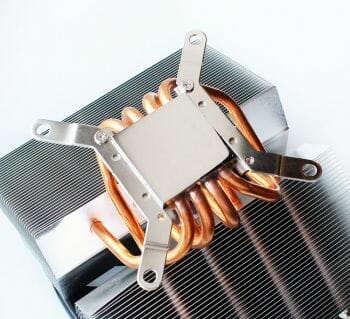
After that you apply a layer of thermal paste onto the processor heat-spreader, install the cooler and either push the plastic pins in to lock it in place, or tighten the four screws with the provided wrench (LGA 2011). The entire process doesn’t take more than 5 minutes, which is an indisputable advantage of Scythe Grand Kama Cross Rev. B.
Due to the angled arrangement of the heatsink arrays, Scythe Grand Kama Cross will never interfere not only with the heatsinks on the mainboard’s voltage regulator components, but also with the tallest memory heat-spreaders. As for the preferred orientation of the cooler, the instructions manual suggests that the cooler should be installed with the heatpipes positioned horizontally (or perpendicular to the memory modules):
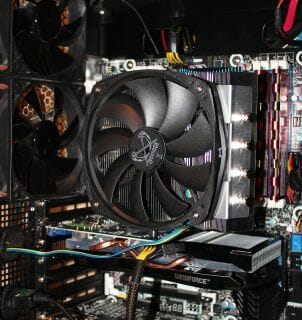
This is exactly the way we installed Scythe Grand Kama Cross Rev. B for our today’s test session.
Testbed Configuration and Testing Methodology
We tested all coolers inside a closed system case with the following configuration:
- Mainboard: Intel Siler DX79SI (Intel X79 Express, LGA 2011, BIOS 0537 from 07/23/2012);
- CPU: Intel Core i7-3960X Extreme Edition, 3.3 GHz, 1.2 V, 6 x 256 KB L2, 15 MB L3 (Sandy Bridge-E, C1, 32 nm);
- Thermal interface: ARCTIC MX-4;
- Graphics card: Gigabyte GeForce GTX 650 Ti 2 GB (GV-N65TOC-2GI);
- System memory: DDR3 4 x 4GB Mushkin Redline (Spec: 2133 MHz / 9-11-10-28 / 1.65 V);
- System drive: Crucial m4 256 GB SSD;
- Drive for programs and games: Western Digital VelociRaptor (300GB, SATA-II, 10000 RPM, 16MB cache, NCQ) inside Scythe Quiet Drive 3.5” HDD silencer and cooler;
- Backup drive: Samsung Ecogreen F4 HD204UI (SATA-II, 2 TB, 5400 RPM, 32 MB, NCQ);
- System case: Antec Twelve Hundred (front panel: three Noiseblocker NB-Multiframe S-Series MF12-S2 fans at 1020 RPM; back panel: two Noiseblocker NB-BlackSilent PRO PL-1 fans at 1020 RPM; top panel: standard 200 mm fan at 400 RPM);
- Control and monitoring panel: Zalman ZM-MFC3;
- Power supply: Seasonic SS-1000XP Active PFC F3 1000 W (with a default 120 mm fan).
For the today’s tests we overclocked our six-core processor with the clock generator frequency set at 125 MHz, the multiplier at 34x and “Load-Line Calibration” enabled to 4.25 GHz. The nominal processor Vcore was increased to 1.35 V in the mainboard BIOS. Turbo Boost was disabled during this test session, and Hyper-Threading technology was enabled to increase the heat dissipation. The memory voltage was at 1.65 V and its frequency was 2000 MHz with 9-11-10-28 timings. All other parameters available in the mainboard BIOS and related to CPU or memory overclocking remained unchanged.
All tests were performed under Windows 7 Ultimate x64 SP1 operating system. We used the following software during our test session:
- LinX AVX Edition version 0.6.4 – to load the processor (memory – 4500 MB, Problem Size – 24234, two 11-minute cycles);
- Real Temp GT version 3.70 – to monitor the processor core temperatures;
- Intel Extreme Tuning Utility version 3.1.201.5 – for monitoring and visual control of all system parameters during overclocking.
So, the complete screenshot during the test session looks as follows:
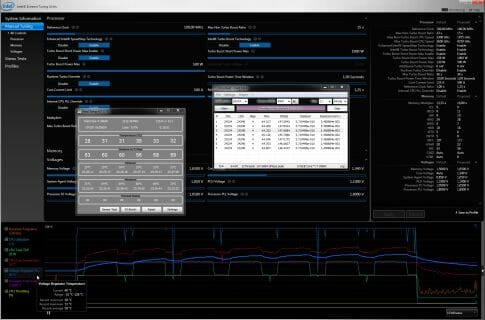
The CPU was loaded with two consecutive LinX AVX test runs with the settings as indicated above. The stabilization period for the CPU temperature between the two test cycles was about 8-10 minutes. We took the maximum temperature of the hottest CPU core for the results charts. Moreover, we will also provide a table with the temperature readings for all cores including their average values. The ambient temperature was checked next to the system case with an electronic thermometer with 0.1 °C precision that allows hourly monitoring of the temperature changes over the past 6 hours. The room temperature during our test session varied between 21.6-22.0°C.
The noise level of each cooler was measured between 1:00 and 3:00 AM in a closed room about 20 m2 big using CENTER-321 electronic noise meter. The noise level for each cooler was tested outside the system case when the only noise sources in the lab were the cooler and its fan. The noise meter was installed on a tripod and was always at a 150 mm distance from the cooler fan rotor. The tested cooling systems were placed at the edge of the desk on a sheet of polyurethane foam. The lowest noise reading our noise meter device can register is 29.8 dBA and the subjectively comfortable noise level in these testing conditions was around 36 dBA (do not mix it up with low noise level). The fan(s) rotation speed was adjusted in the entire supported range using our in-house controller by changing the voltage with 0.5 V increment.
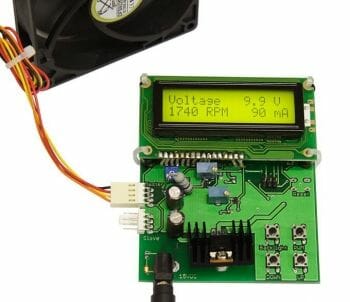
It would make sense to compare the cooling efficiency and noise of Scythe Grand Kama Cross Rev. B against those of another top-cooler, but unfortunately, we didn’t have one handy at the time of tests. Therefore, we took the retail price of the Grand Kama Cross ($40) as our competitive criterion and chose a rival with the same price tag, but tower-design: Thermalright TRUE Spirit 120 with one default 120 mm fan:
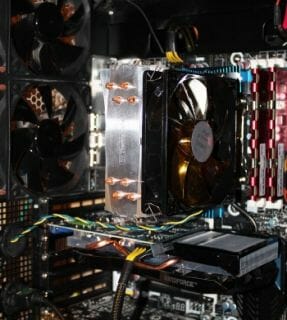
The rotation speed of all fans was controlled using the same special controller I mentioned above with ±10 RPM precision and 200 RPM increments.
Performance
Cooling Efficiency
The results of our cooling efficiency tests on Scythe Grand Kama Cross Rev. B and its competitor in LGA 2011 platform are given in the following table and diagram:

Frankly speaking, we didn’t expect Scythe Grand Kama Cross Rev. B to do so well! Not only did it outperform a tower-cooler in efficiency, but it proved better than the price segment performance leader! Moreover, Grand Kama Cross turned out more efficient almost in all operational modes. For example, if the coolers are equal at maximum fan speeds, then at 1200 RPM Scythe’s top-cooler wins 4°C in peak temperature from Thermalright, at 1100 RPM – 6°C, and at 800 RPM – 7°C. To be fair I have to say that Grand Kama Cross has a 140 mm fan, while TRUE Spirit 120 – a 120 mm fan. We are going to dwell on their acoustic performance a little later, but I have to admit that we were pleasantly surprised with the outstanding results of the Scythe Grand Kama Cross Rev. B.
Of course, we didn’t stop at this and attempted to overclock our six-core processors even further under Scythe Grand Kama Cross Rev. B. The next step was supposed to be 4.375 GHz at 1.385~1.4 V Vcore. Unfortunately, the Japanese top-cooler failed to maintain stability for our processor at these speeds and each of our attempts ended in a system freeze or an error like that:
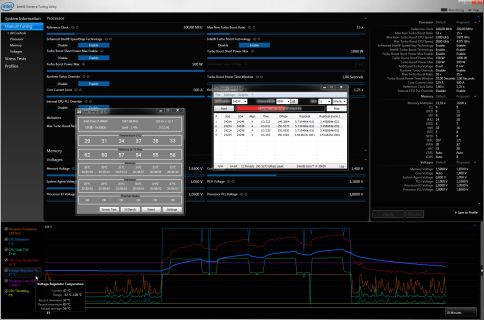
However, Thermalright TRUE Spirit 120 coped with the tests in the same conditions at 80°C peak temperature:
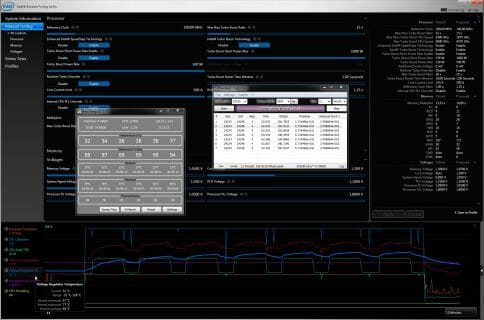
In other words, we can conclude that Scythe Grand Kama Cross Rev. B does really well during moderate processor overclocking and can successfully compete even against a recognized price segment leader. Unfortunately, this is all it can do. Higher frequencies remain unattainable.
Acoustic Performance
We measured the noise level of the two tested coolers throughout the entire speed range of their fans, as described in the chapter on testing methodology. Here are the results:
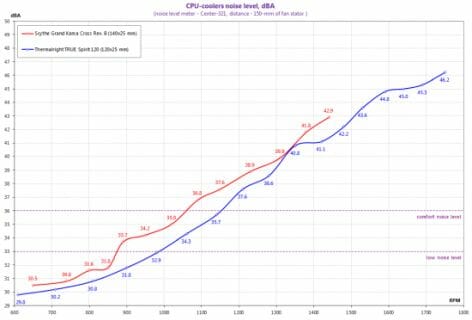
Despite fans of different diameter, the noise curves for Scythe Grand Kama Cross Rev. B and Thermalright TRUE Spirit 120 are very close. And even though top-cooler loses to its competitor in this aspect, the difference is pretty small, as we can see. The 140 mm Scythe fan remains in a subjectively comfortable acoustic zone up to 1050 RPM, while the 120 mm Thermalright fan is still acoustically comfortable at 100 RPM higher speed. In quiet mode the RPM difference is a little higher 860~870 RPM for Grand Kama Cross and 980~990 RPM for TRUE Spirit 120. Nevertheless, going back to the cooling efficiency tests now that we know the noise readings we can conclude that lower noise of Thermalright TRUE Spirit 120 doesn’t save this tower-cooler from an overall defeat from Scythe Grand Kama Cross Rev. B. Even at maximum fan speeds.
Conclusion
The formally modified Scythe Grand Kama Cross Rev. B accomplished something practically impossible: it outperformed the reigning leader in the $40 price segment in cooling efficiency and acoustics. Most remarkably, it is a top-cooler, and not another tower, which could be more logical and predictable, based on our experience in the field. At the same time, do not forget that Thermalright TRUE Spirit 120 will still be preferable for more aggressive CPU overclocking. As for Scythe Grand Kama Cross Rev. B, this model has definitely not exhausted the potential for further modifications and improvements. Take, for instance, the missing grooves in the base plate where the heatpipes are soldered, higher-pressure retention, or silicone mounts for the 140 mm fan instead of the screws. Time will show if Scythe decides to implement any of these and when. Today, Scythe Grand Kama Cross Rev. B is a very worthy top-cooler for systems with moderately overclocked processors. And taking into account the popularity of Scythe products, very competitive price of Grand Kama Cross Rev. B, its universal design, simple installation and efficient cooling of the around-the-socket area and memory modules, this cooler should become pretty popular. And we wish it all the best!